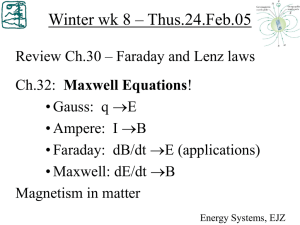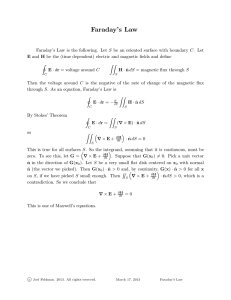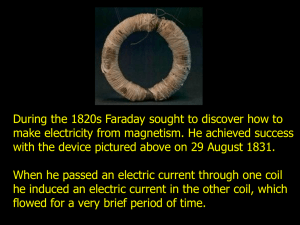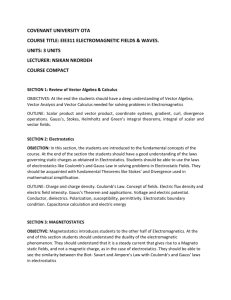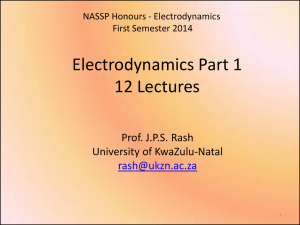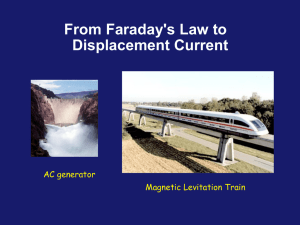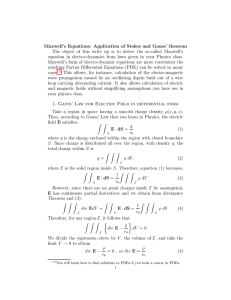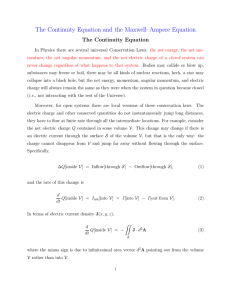Lecture 27
advertisement
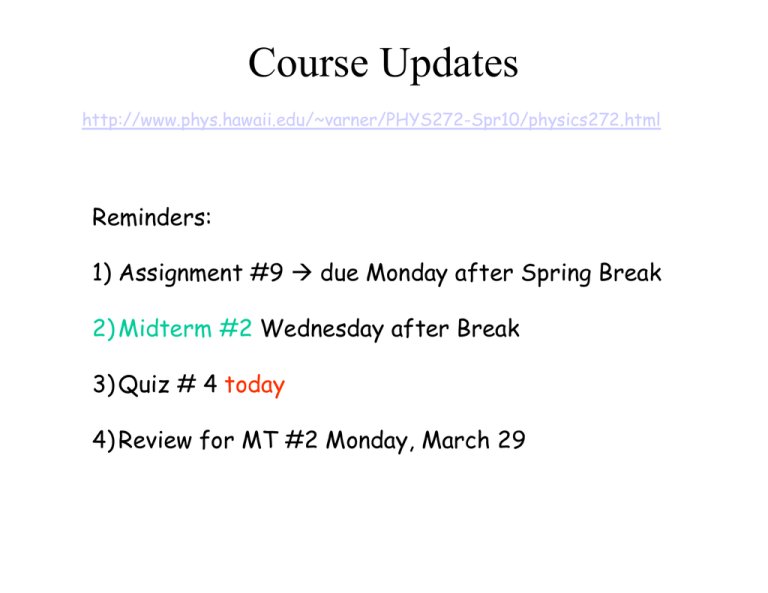
Course Updates http://www.phys.hawaii.edu/~varner/PHYS272-Spr10/physics272.html Reminders: 1) Assignment #9 Æ due Monday after Spring Break 2) Midterm #2 Wednesday after Break 3) Quiz # 4 today 4) Review for MT #2 Monday, March 29 Faraday’s Law (reminder) What causes current to flow in wire? Answer: an E field in the wire. A changing magnetic flux not only causes an EMF around a loop but an induced electric field. Can write Faraday’s Law: r r d r r dΦ B ε = ∫ E ⋅ dl = − ∫ B ⋅ dA = − dt dt Remember for a long straight wire of length l, V = El. Note: For electric fields from static charges, the EMF from a closed path is always zero. Not true here. There are two sources for electric fields! Eddy Currents Changing magnetic fields in metal induce eddy currents, reducing strength of received B field. Example: metal detector Eddy currents often useful. Maxwell’s Equations (integral form) Name Equation Gauss’ Law for Electricity r r Q ∫ E ⋅ dA = Gauss’ Law for Magnetism r r ∫ B ⋅ dA = 0 ε0 Faraday’s Law r r dΦ B ∫ E ⋅ dl = − dt Ampere’s Law r ∫ B ⋅ dl = μ 0 i Needs to be modified. There is a serious asymmetry. Description Charge and electric fields Magnetic fields Electrical effects from changing B field Magnetic effects from current +? Remarks on Gauss Law’s with different closed surfaces r r Qenclosed ∫ E ⋅ dA = r r ∫ B ⋅ dA = 0 ε0 Gauss Law’s works for ANY CLOSED SURFACE square cylinder Surfaces for integration of E flux sphere bagel Remarks on Faraday’s Law with different attached surfaces r r r r d ∫ B ⋅ dA ∫ E ⋅ dl = − dt Line integral defines the Closed loop disk Faraday’s Law works for any closed Loop and ANY attached surface area Surface area integration for B flux cylinder Fish bowl This is proved in Vector Calculus with Stoke’s Theorem Generalized Ampere’s Law and displacement current r ∫ B ⋅ dl = μ0 I enclosed , is incomplete. Ampere’s original law, Consider the parallel plate capacitor and suppose a current ic is flowing charging up the plate. If Ampere’s law is applied for the given path in either the plane surface or the bulging surface we we should get the same results, but the bulging surface has ic=0, so something is missing. Generalized Ampere’s Law and displacement current Maxwell solved dilemma by adding an additional term called displacement current, iD = ε dΦE/dt, in analogy to Faraday’s Law. r dΦ E ⎞ ⎛ ∫ B ⋅ dl = μ 0 (ic + iD ) = μ 0 ⎜⎝ ic + ε 0 dt ⎟⎠ Current is once more continuous: iD between the plates = iC in the wire. q = CV εA = ( Ed ) d = εEA = εΦ E dq dΦ E = ic = ε dt dt Summary of Faraday’s Law r r dΦ B ∫ E ⋅ dl = − dt If we form any closed loop, the line integral of the electric field equals the time rate change of magnetic flux through the surface enclosed by the loop. B If there is a changing magnetic field, then there will be electric fields induced in closed paths. The electric fields direction will tend to reduce the changing B field. Note; it does not matter if there is a wire loop or an imaginary closed path, an E field will be induced. Potential has no meaning in this non-conservative E field. E Summary of Ampere’s Generalized Law r dΦ E ⎞ ⎛ ⎟ ∫ B ⋅ dl = μ 0 ⎜ ic + ε 0 dt ⎠ ⎝ Current ic If we form any closed loop, the line integral of the B field is nonzero if there is (constant or changing) current through the loop. If there is a changing electric field through the loop, then there will be magnetic fields induced about a closed loop path. B E B Maxwell’s Equations James Clerk Maxwell (1831-1879) • generalized Ampere’s Law • made equations symmetric: – a changing magnetic field produces an electric field – a changing electric field produces a magnetic field • Showed that Maxwell’s equations predicted electromagnetic waves and c =1/√ε0μ0 • Unified electricity and magnetism and light. All of electricity and magnetism can be summarized by Maxwell’s Equations. Maxwell’s Equations (integral form – also diff form) Name Equation Gauss’ Law for Electricity r r Q ∫ E ⋅ dA = Gauss’ Law for Magnetism r r ∫ B ⋅ dA = 0 Faraday’s Law Generalized Ampere’s Law ε0 r r dΦ B ∫ E ⋅ dl = − dt r dΦ E ⎞ ⎛ μ ε B ⋅ dl = i + ⎟ ∫ 0⎜ c 0 dt ⎠ ⎝ Description Charge and electric fields Magnetic fields Electrical effects from changing B field Magnetic effects from current … and then out of the darkness, there was light Spring Break fun? • Enjoy next week – though get HW #9 done • Review on Monday; go over practice exam [Midterm 2 is Chap 25 – 29] • Quiz now! After quick summary

